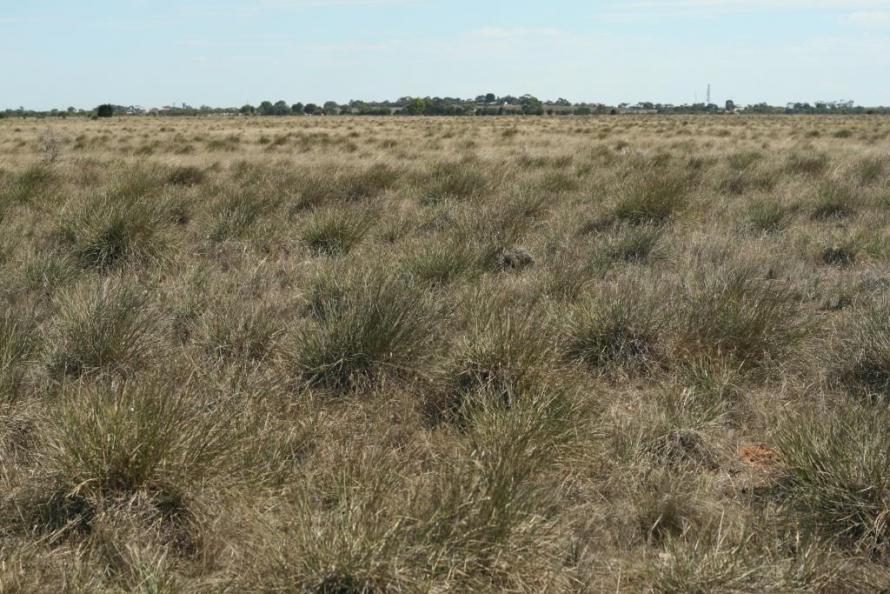
Poonthie Ruwe Conservation Park has relatively flat terrain, with very shallow loam over calcrete rock, which outcrops frequently throughout the park. The soluble nature of calcrete has lead to the formation of small ‘potholes’ throughout the park. These ‘potholes’ provide habitat for native fauna, particularly reptiles, although rabbits have been known to use these burrows in the past as well. Sandy soil has blown onto the southern edge of the property from a small, disturbed dune on the adjacent block. The name ‘Poonthie Ruwe’ means ‘Hopping Mouse Country’ in the local Ngarrindjeri language.
Eastern side of Dukes Highway 4-5 km southeast of Tailem Bend, which is 95 km southeast of Adelaide
Interpretive signage
Proclaimed as a conservation park in 2003. The park has a history of grazing which ceased from 1994 under a native vegetation heritage agreement.
The conservation park was established because of its significant area of Lomandra effusa iron-grass grassland, which is protected as Critically Endangered under the EPBC Act. The park contains 13 plant species of conservation significance.
Iron-grass Natural Temperate Grasslands of South Australia. Small area of callitris open woodland in the SE corner of park.
Spring is the best time to see the small herbaceous plants in the ecosystem growing and flowering. The southern part of the park has the best flora diversity.
Management activities have been very limited since the park was proclaimed. Some weed control and fence maintenance. Consideration currently being given to grazing and fire options to reduce the impact of annual weeds.
Acacia nyssophylla, Aristida behriana, Arthropodium fimbriatum, Arthropodium minus, Arthropodium strictum, Austrostipa acrociliata, Austrostipa elegantissima, Austrostipa eremophila, Austrostipa nitida, Austrostipa nodosa, Austrostipa scabra subsp. falcata, Brachyscome lineariloba, Bulbine bulbosa, Calandrinia calyptrata, Callitris gracilis, Chrysocephalum apiculatum, Clematis microphylla, Convolvulus angustissimus subsp. peninsularum, Convolvulus erubescens, Convolvulus remotus, Crassula colligata subsp. lamprosperma, Crassula sieberiana, Crassula tetramera, Daucus glochidiatus, Dodonaea viscosa subsp. spatulata, Drosera glanduligera, Enneapogon nigricans, Eucalyptus leptophylla, Eucalyptus odorata, Eucalyptus phenax, Eucalyptus porosa, Euphorbia drummondii, Gahnia lanigera, Goodenia pinnatifida, Goodenia pusilliflora, Helichrysum leucopsideum, Hyalosperma demissum, Hyalosperma semisterile, Isoetopsis graminifolia, Lepidosperma congestum, Lomandra effusa, Melaleuca lanceolata, Microtis arenaria, Muehlenbeckia gunnii, Ophioglossum lusitanicum, Oxalis perennans, Pittosporum angustifolium, Podolepis rugata, Podolepis tepperi, Pogonolepis muelleriana, Prasophyllum occidentale, Pterostylis biseta, Pterostylis mutica, Ptilotus spathulatus, Rytidosperma caespitosum, Sebaea ovata, Senecio pinnatifolius, Senecio spanomerus, Thysanotus baueri, Triodia irritans, Triptilodiscus pygmaeus, Vittadinia megacephala, Wahlenbergia gracilenta, Wahlenbergia luteola, Wurmbea dioica subsp. dioica
A range of reptiles and birds use the reserve including Shingleback, Eastern Striped-skink, Dwarf Skink, and Brown Snake, Diamond Firetail, Blue Bonnet, Striped Honeyeater, Elegant Parrot, Peaceful Dove, Black-eared Cuckoo, Southern Whiteface and White-winged Chough.